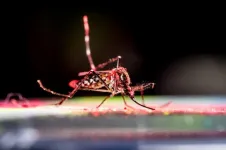(Press-News.org) Technology is edging closer and closer to the super-speed world of computing with artificial intelligence. But is the world equipped with the proper hardware to be able to handle the workload of new AI technological breakthroughs?
“The brain-inspired codes of the AI revolution are largely being run on conventional silicon computer architectures which were not designed for it,” explains Erica Carlson, 150th Anniversary Professor of Physics and Astronomy at Purdue University.
A joint effort between Physicists from Purdue University, University of California San Diego (USCD) and École Supérieure de Physique et de Chimie Industrielles (ESPCI) in Paris, France, believe they may have discovered a way to rework the hardware…. By mimicking the synapses of the human brain. They published their findings, “Spatially Distributed Ramp Reversal Memory in VO2” in Advanced Electronic Materials which is featured on the back cover of the October 2023 edition.
New paradigms in hardware will be necessary to handle the complexity of tomorrow’s computational advances. According to Carlson, lead theoretical scientist of this research, “neuromorphic architectures hold promise for lower energy consumption processors, enhanced computation, fundamentally different computational modes, native learning and enhanced pattern recognition.”
Neuromorphic architecture basically boils down to computer chips mimicking brain behavior. Neurons are cells in the brain that transmit information. Neurons have small gaps at their ends that allow signals to pass from one neuron to the next which are called synapses. In biological brains, these synapses encode memory. This team of scientists concludes that vanadium oxides show tremendous promise for neuromorphic computing because they can be used to make both artificial neurons and synapses.
"The dissonance between hardware and software is the origin of the enormously high energy cost of training, for example, large language models like ChatGPT,” explains Carlson. “By contrast, neuromorphic architectures hold promise for lower energy consumption by mimicking the basic components of a brain: neurons and synapses. Whereas silicon is good at memory storage, the material does not easily lend itself to neuron-like behavior. Ultimately, to provide efficient, feasible neuromorphic hardware solutions requires research into materials with radically different behavior from silicon – ones that can naturally mimic synapses and neurons. Unfortunately, the competing design needs of artificial synapses and neurons mean that most materials that make good synaptors fail as neuristors, and vice versa. Only a handful of materials, most of them quantum materials, have the demonstrated ability to do both.”
The team relied on a recently discovered type of non-volatile memory which is driven by repeated partial temperature cycling through the insulator-to-metal transition. This memory was discovered in vanadium oxides.
Alexandre Zimmers, lead experimental scientist from Sorbonne University and École Supérieure de Physique et de Chimie Industrielles, Paris, explains, “Only a few quantum materials are good candidates for future neuromorphic devices, i.e., mimicking artificial synapses and neurons. For the first time, in one of them, vanadium dioxide, we can see optically what is changing in the material as it operates as an artificial synapse. We find that memory accumulates throughout the entirety of the sample, opening new opportunities on how and where to control this property.”
“The microscopic videos show that, surprisingly, the repeated advance and retreat of metal and insulator domains causes memory to be accumulated throughout the entirety of the sample, rather than only at the boundaries of domains,” explains Carlson. “The memory appears as shifts in the local temperature at which the material transitions from insulator to metal upon heating, or from metal to insulator upon cooling. We propose that these changes in the local transition temperature accumulate due to the preferential diffusion of point defects into the metallic domains that are interwoven through the insulator as the material is cycled partway through the transition.”
Now that the team has established that vanadium oxides are possible candidates for future neuromorphic devices, they plan to move forward in the next phase of their research.
"Now that we have established a way to see inside this neuromorphic material, we can locally tweak and observe the effects of, for example, ion bombardment on the material's surface,” explains Zimmers. “This could allow us to guide the electrical current through specific regions in the sample where the memory effect is at its maximum. This has the potential to significantly enhance the synaptic behavior of this neuromorphic material.”
About the Department of Physics and Astronomy at Purdue University
Purdue Department of Physics and Astronomy has a rich and long history dating back to 1904. Our faculty and students are exploring nature at all length scales, from the subatomic to the macroscopic and everything in between. With an excellent and diverse community of faculty, postdocs, and students who are pushing new scientific frontiers, we offer a dynamic learning environment, an inclusive research community, and an engaging network of scholars.
Physics and Astronomy is one of the seven departments within the Purdue University College of Science. World-class research is performed in astrophysics, atomic and molecular optics, accelerator mass spectrometry, biophysics, condensed matter physics, quantum information science, particle and nuclear physics. Our state-of-the-art facilities are in the Physics Building, but our researchers also engage in interdisciplinary work at Discovery Park District at Purdue, particularly the Birck Nanotechnology Center and the Bindley Bioscience Center. We also participate in global research including at the Large Hadron Collider at CERN, many national laboratories (such as Argonne National Laboratory, Brookhaven National Laboratory, Fermilab, Oak Ridge National Laboratory, the Stanford Linear Accelerator, etc.), the James Webb Space Telescope, and several observatories around the world.
About Purdue University
Purdue University is a public research institution with excellence at scale. Ranked among top 10 public universities and with two colleges in the top 4 in the United States, Purdue discovers and disseminates knowledge with a quality and at a scale second to none. More than 105,000 students study at Purdue across modalities and locations, with 50,000 in person on the West Lafayette campus. Committed to affordability and accessibility, Purdue’s main campus has frozen tuition 12 years in a row. See how Purdue never stops in the persistent pursuit of the next giant leap, including its first comprehensive urban campus in Indianapolis, the new Mitchell E. Daniels, Jr. School of Business, and Purdue Computes, at https://www.purdue.edu/president/strategic-initiatives.
Contributors:
Erica Carlson, 150th Anniversary Professor of Physics and Astronomy at Purdue University
Alexandre Zimmers, Associate Professor, Sorbonne Université and École Supérieure de Physique et de Chimie Industrielles, Paris, France
Written by Cheryl Pierce, Communications Specialist
Index: S. Basak, Y. Sun, M. Alzate Banguero, P. Salev, I. K. Schuller, L. Aigouy, E. W. Carlson, A. Zimmers, “Spatially Distributed Ramp Reversal Memory in VO2,” Advanced Electronic Materials aelm.202300085 (2023).
END
Neuromorphic computing will be great… if hardware can handle the workload
A scientific team, including Purdue University, propose hardware that mimics the human brain
2023-11-06
ELSE PRESS RELEASES FROM THIS DATE:
Lightening the load: Beckman researchers develop autonomous electrochemistry robot
2023-11-06
Researchers at the Beckman Institute for Advanced Science and Technology developed an automated laboratory robot to run complex electrochemical experiments and analyze data.
With affordability and accessibility in mind, the researchers collaboratively created a benchtop robot that rapidly performs electrochemistry. Aptly named the Electrolab, this instrument greatly reduces the effort and time needed for electrochemical studies by automating many basic and repetitive laboratory tasks.
The Electrolab can be used to explore energy storage materials and chemical reactions that promote the use of alternative ...
Success of Wolbachia-infected mosquitoes in fighting dengue may be underestimated
2023-11-06
The fight against dengue fever has a new weapon: a mosquito infected with the bacteria Wolbachia, which prevents the spread of the virus. These mosquitoes have now been deployed in several trials demonstrating their potential in preventing disease transmission.
Now, researchers at the University of Notre Dame have conducted an analysis of the World Mosquito Program’s randomized control trial of Wolbachia-infected mosquitoes in Indonesia, looking at how excluding transmission dynamics impacted the original interpretation of the trial’s results.
“Randomized controlled trials are the gold standard for evaluating the efficacy of any ...
The uncharted role of HER2 mutant alleles in breast cancer
2023-11-06
“Our research study has demonstrated that poziotinib is highly potent in neratinib-resistant HER2 L755S lobular and ductal breast cancer models [...].”
BUFFALO, NY- November 6, 2023 – A new editorial paper was published in Oncotarget's Volume 14 on October 31, 2023, entitled, “The uncharted role of HER2 mutant alleles in breast cancer.”
Somatic HER2 mutations are a novel class of therapeutic targets across different cancer types. Treatment with the tyrosine kinase inhibitor (TKI) neratinib ...
From basic research to application: NRL geophysicist awarded NDIA Undersea Warfare Bronze Medal Achievement in Science
2023-11-06
WASHINGTON – Warren Wood, Ph.D., U.S. Naval Research Laboratory Ocean Sciences Division’s Geology and Geophysics section head, received the National Defense Industrial Association (NDIA) Bronze Medal on Sept. 19, 2023 during a ceremony held at the Naval Submarine Base in Groton, Conn. for outstanding individual achievement in undersea warfare.
This award-winning work would not have been possible without fantastic teamwork, especially from the staff in Geology and Geophysics and Acoustic Simulation, Measurements & Tactics Branches,” said Wood. “Essentially a software ...
Study highlights optimal timing for assessing orthostatic hypotension in older adults and its impact on fall risk
2023-11-06
A new study, "Timing of Orthostatic Hypotension and its Relationship with Falls in Older Adults", has brought critical insights into the assessment of orthostatic hypotension, a drop in blood pressure commonly found among older adults when transitioning from a sitting or lying position to a standing position that can lead to dizziness and falls.
Published in the Journal of the American Geriatrics Society (JAGS) and based on a secondary analysis of the "Study to Understand Fall Reduction and Vitamin D in You (STURDY)," this study examined the prevalence of orthostatic hypotension at different time points after ...
RIT researcher looks for genetic switch to prevent ‘sleeping sickness’ in cattle
2023-11-06
As parasites adapt to a warming world, an infectious disease expert at Rochester Institute of Technology has his eye on the tsetse fly in sub-Saharan Africa. The biting fly transmits Trypanosomiasis, or “sleeping sickness,” to cattle there and could someday migrate to northern climates, including to the United States.
RIT researcher Bolaji Thomas is leading a $650,000 study funded by the U.S. Department of Agriculture, the National Institute of Food and Agriculture, and the Agriculture ...
Improving the efficacy of cancer immunotherapy with modified CAR-T cells
2023-11-06
CAR-T cell therapy is a last hope for many patients with blood, bone marrow or lymph gland cancer when other treatments such as chemotherapy are unsuccessful. A limiting factor of this otherwise very effective and safe therapy is that the cells used in the process quickly reach a state of exhaustion. Researchers at the University of Freiburg have now been able to prevent this exhaustion and thus significantly improve the effect of the therapy in a preclinical animal model. The new results have been published in the journal Nature Immunology.
Using the body’s own defences ...
UMD researchers developed a nasal vaccine that prevents COVID in preclinical studies
2023-11-06
A team of University of Maryland researchers developed a nasal spray vaccine that delivers the SARS-CoV-2 spike protein into cells of the airway in mice and hamsters, triggering an immune response that significantly reduced infection and spread of COVID-19. The technology can be adapted to induce immunity to other respiratory illnesses, such as influenza and respiratory syncytial virus (RSV) infections.
A nasal vaccine for respiratory viruses would be a significant improvement over intramuscular shots, because they are less invasive and stop viral particle replication in the airway, before a virus can enter the bloodstream. This could improve the rate ...
Learning more about how flu strains evolved may help guide future vaccine development – SFU research
2023-11-06
Simon Fraser University researchers studying the evolutionary history of flu viruses have found that a new quantitative analysis of how they evolved may help predict future strains. The research draws on a field known as phylogenetics, which focuses on how groups of organisms are evolutionarily related, and is published in the journal Science Advances.
Researchers used large phylogenetic ‘trees’ to predict which strains are most likely to grow during the upcoming flu season, and determined that this approach was moderately effective in detecting future strains of the influenza virus, and could be another tool in the toolbox to guide seasonal ...
UTSA psychology professor, grad student to research cognitive impairment in cancer patients
2023-11-06
(SAN ANTONIO, NOVEMBER 6, 2023) — The University of Texas at San Antonio (UTSA) associate professor of psychology Joe Houpt, is part of a team that has earned a one-year, $50,000 grant from the Mays Cancer Center at the University of Texas Health Science Center at San Antonio (UT Health San Antonio).
The project, “Surviving is Not Enough: Enhancing Cognitive Function in Cancer Survivors through Movement and Introspection,” aims to measure and enhance the cognitive functioning of cancer survivors at the Mays Cancer ...
LAST 30 PRESS RELEASES:
Potential new treatment for sepsis
Study reveals how many hours of video games per week might be too many
Electrospinning for mimicking bioelectric microenvironment in tissue regeneration
Home fingertip oxygen monitors less accurate for people with darker skin tones
Six weeks in a cast no less effective than surgery for unstable ankle fractures
Precautionary approach to alcohol-free and low alcohol drinks needed to protect public health, say experts
Gas-atomized Ca–Mg alloy powders produce hydrogen simply by adding water — high-efficiency hydrogen generation at room temperature
British redcoat’s lost memoir reveals harsh realities of life as a disabled veteran
World-leading rare earth magnet recycling facility launches in UK
Corday Selden selected for the Oceanography Society Early Career Award
MIT chemists determine the structure of the fuzzy coat that surrounds Tau proteins
Same moves, different terrain: How bacteria navigate complex environments without changing their playbook
Severe weather is deadly for vulnerable older adults long after the storm ends, study finds
Expert panel highlights opportunities for improving cancer studies
Hearing aid prescriptions not associated with changes in memory and thinking
Seth Zippel selected for The Oceanography Society Early Career Award
Jeremy Horowitz selected for The Oceanography Society Early Career Award
Kennesaw State University’s Jerry Mack named Paul “Bear” Bryant Newcomer Coach of the Year
Ancient teeth are treasure troves of data on Iron Age lifestyles
Avocados may become easier to grow in India—but not if global emissions remain high
Pregnant women with IBD show heightened inflammation in vaginal mucosa
Underwater photos show seabirds, seals and fish interacting with a tidal turbine in Washington State
1 in 5 surveyed UK adults who have experienced the death of a pet report it as more distressing than experienced human deaths, with significant rates of prolonged grief disorder symptoms also being re
Polyester microfibers in soil negatively impact the development of cherry tomato plants in experiments, raising concerns over the potential effect of high levels of such contaminants
LGBTQ+ adults may be around twice as likely to be unemployed or to report workforce non-participation compared to heterosexual adults, per large representative Australian survey
Horses can smell fear: In experiments where horses smelled sweat from scared humans, they reacted to scary and sudden events with increased fear and reduced human interaction
New synaptic formation in adolescence challenges conventional views of brain development
Scientists identify target to treat devastating brain disease
Oliver Zielinski selected as Fellow of The Oceanography Society
Has progress stalled on gender equality at work?
[Press-News.org] Neuromorphic computing will be great… if hardware can handle the workloadA scientific team, including Purdue University, propose hardware that mimics the human brain



